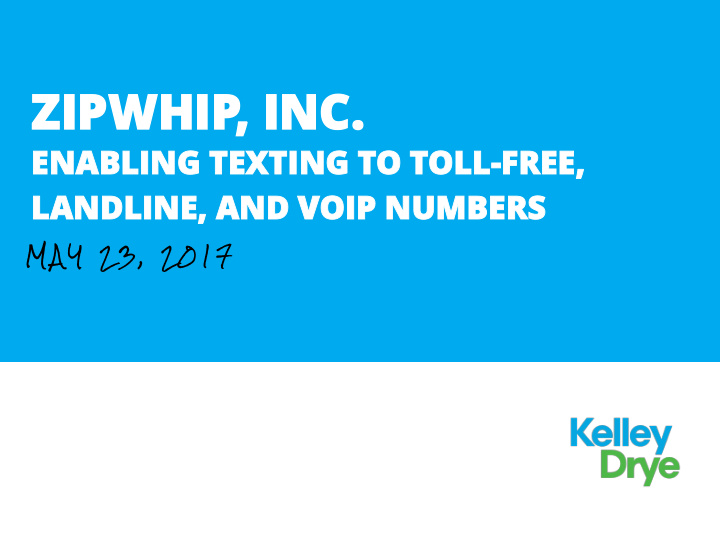



ZIPWHIP ZIPWHIP, , INC. INC. ENA ENABLING TEXT BLING TEXTING ING TO O TOLL OLL-FREE FREE, , LANDLINE, AND V LANDLINE, AND VOIP NUMBER OIP NUMBERS M A Y 2 3 , 2 0 1 7 KATHLEEN W. CANNON DAVID E. FINK Partner Partner International Trade Media and Entertainment HENRY T. KELLY ROBERT I. STEINER Partner Partner Communications Litigation
About Zipwhip Zipwhip is a start-up that developed the routing infrastructure to introduce texting to toll-free, landline, and VoIP numbers Zipwhip’s infrastructure provides a single interface for termination of commercial volume texting w/ A2P Use of A2P channels enables trusted texting Enables texting based upon the principle that the subscriber controls the use of its number Uses multi- factored validation procedures to verify the subscriber associated with a particular number Maintains network infrastructure level safeguards against spam and phishing 2
Overview Prior to 2016, Somos tried to convince the FCC that texting services should be treated like Title II In 2016, Somos reversed course, seeking a “declaratory ruling” based on the idea that toll -free texting has always been regulated Petition should be denied Seeks a new rulemaking and new obligations NOT a declaratory ruling Would undercut subscriber control and establish a regulatorily created monopoly Toll-free numbers may be used as identifiers in many contexts without regulation 3
State of the Texting on Toll-Free Marketplace Before 2014, there was no practical way to exchange commercial text messages with toll-free numbers Cross-carrier support for texting on toll-free only began in August 2015 Business texting market is thriving due to investment and innovations Major brands are adopting texting as a consumer communication channel Business model is still being proven; there are not significant profits for carriers or for Zipwhip 4
Existing Industry Methods are Reasonable, and They Work No epidemic of toll-free numbers being hijacked or text-enabled without subscriber permission Industry-consensus guidelines in place including CTIA Messaging Principles and Best Practices CTIA recently updated these principles through an industry consensus process CTIA principles permit either use of a registry or the independent verification that Zipwhip uses Existing methods coalesce around the core principle that the subscriber controls the use of its number Key factor is validation of subscriber identity and ownership of the number 5
Existing Industry Methods are Reasonable, and They Work Fundamental to Zipwhip’s verification process is calling the number to ensure that the customer seeking to enable has actual control If subscriber identity is still in doubt, a registry and other public information sources are consulted In disputed scenarios, Zipwhip may require a letter of authorization There is nothing unique to texting about verifying ownership when toll-free numbers are used as identifiers OTT applications Internet urls Email addresses 6
Issues with Somos’s Declaratory Ruling Petition Procedurally improper Inconsistent with declaratory ruling purpose, to clarify existing rules not substantively change it or essentially create a new rule Identifies no statutory provision, rule or order that imposes the requirements it seeks or is related to texting to toll-free Not wise policy Proposal would undermine subscriber control and insert RespOrgs in a controlling position Requested mandate would hinder innovation and potentially damage a rapidly evolving marketplace Not needed Industry-consensus guidelines in place to deal with proper verification and consumer protection; Zipwhip compliant with these 7
Somos’s Request Is Contrary To Chairman Pai’s Regulatory Philosophy “Consumers benefit most from competition, not preemptive Somos’s request shuns competition regulation. Free markets have delivered more value to in favor of a regulated market American consumers than highly regulated ones.” – Pai Regulatory Philosophy “No regulatory system should indulge arbitrage; regulators Somos’s request seeks regulatory should be skeptical of pleas to regulate rivals, dispense favors favors, or otherwise afford special treatment.” - Pai Regulatory Philosophy “One could read the entire document . . . without finding Somos’s request relies on anything more than hypothesized harms. Or in other hypothesized harms words, public- utility regulation was a solution that wouldn’t work for a problem didn’t exist.” – Speech to Free State Foundation (Dec. 2016, discussing Open Internet Order) “Proof of market failure should guide the next Commission's Somos’s request doesn’t show considerations of new regulations. And the FCC should only market failure adopt a regulation if it determines that its benefits outweigh its costs.” – Speech to Free State Foundation (Dec. 2016) “A . . . key FCC priority is promoting innovation across the Somos’ request undermines communications industry.” “We want to encourage innovation, relies on a 1980s innovation throughout the Internet economy. That means regulatory solution innovation not just at the edge of the network, but within the networks themselves.” – Speech to AEI (May 2017) 8
More recommend